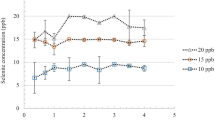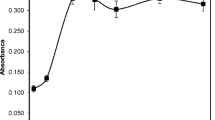Abstract
We have developed a method for the determination of trace levels of total selenium in water samples. It integrates preconcentration, in-situ photoreduction and slurry photochemical vapor generation using TiO2 nanoparticles, and the determination of total selenium by AFS. The Se(IV) and Se(VI) species were adsorbed on a slurry of TiO2 nanoparticles which then were exposed to UV irradiation in the presence of formic acid to form volatile selenium species. The detection limits were improved 17-fold compared to hydride generation and 56-fold compared to photochemical vapor generation, both without any preconcentration. No significant difference was found in the limits of detection (LODs) for Se(IV) and Se(VI). The LOD is as low as 0.8 ng L−1, the precision is better than 4.5 % (at a level of 0.1 μg L−1 of selenium). The method gave good recoveries when applied to the determination of total selenium in a certified tissue reference material (DORM-3) and in spiked drinking water and wastewater samples containing high concentrations of transition and noble metal ions. It also excels by very low LODs, a significant enhancement of sample throughput, reduced reagent consumption and sample loss, and minimal interference by transition and noble metal ions.

A method integrating pre-concentration, in situ photo-reduction and slurry photochemical vapor generation by using TiO2 nanoparticles was developed for sensitive determination of total selenium in various water samples by atomic fluorescence spectrometry.





Similar content being viewed by others
References
Whitfield JB, Dy V, Mcquilty R, Zhu G, Heath AC, Montgomery GW, Martin NG (2010) Genetic effects on toxic and essential elements in humans: arsenic, cadmium, copper, lead, mercury, selenium, and zinc in erythrocytes. Environ Health Perspect 118:776–782
Facompre N, EI-Bayoumy K (2009) Potential stages for prostate cancer prevention with selenium: implications for cancer survivors. Cancer Res 69:2699–2703
da Silva MAO, Arruda MAZ (2012) Identification of selenium in the leaf protein of sunflowers by a combination of 2D-PAGE and laser ablation ICP-MS. Microchim Acta 176:131–136, 181:491-496
Zhang L, Morita Y, Sakuragawa A, Isozaki A (2007) Inorganic speciation of As(III, V), Se(IV, VI) and Sb(III, V) in natural water with GF-AAS using solid phase extraction technology. Talanta 72:723–729
Wang Y, Luo XY, Tang J, Hu XY (2011) Determination of Se(IV) using solidified floating organic drop microextraction coupled to ultrasound-assisted back-extraction and hydride generation atomic fluorescence spectrometry. Microchim Acta 173:267–273
Hernandez PC, Tyson JF, Udena PC, Yatesb D (2007) Determination of selenium by flow injection hydride generation inductively coupled plasma optical emission spectrometry. J Anal At Spectrom 22:298–304
Xing Z, Wang J, Han GJ, Kuermaiti B, Zhang SC, Zhang XR (2010) Depth profiling of nanometer coatings by low temperature plasma probe combined with inductively coupled plasma mass spectrometry. Anal Chem 82:5872–5877
Giussani B, Monticelli D, Rampazzi L (2009) Role of laser ablation–inductively coupled plasma–mass spectrometry in cultural heritage research: a review. Anal Chim Acta 635:6–21
Aramendía M, Resano M, Vanhaecke F (2009) Electrothermal vaporization–inductively coupled plasma-mass spectrometry: a versatile tool for tackling challenging samples: a critical review. Anal Chim Acta 648:23–44
Wu P, He L, Zheng CB, Hou XD, Sturgeon RE (2010) Applications of chemical vapor generation in non-tetrahydroborate media to analytical atomic spectrometry. J Anal At Spectrom 25:1217–1246
Sturgeon RE, Mester Z (2002) Analytical applications of volatile metal derivatives. Appl Spectrosc 56:202A–213A
He YH, Hou XD, Zheng CB, Sturgeon RE (2007) Critical evaluation of the application of photochemical vapor generation in analytical atomic spectrometry. Anal Bioanal Chem 388:769–774
Svecova L, Dossot M, Cremel S, Simonnot M, Sardin M, Humbert B, Auwer CD, Michot LJ (2011) Sorption of selenium oxyanions on TiO2 (rutile) studied by batch or column experiments and spectroscopic methods. J Hazard Mater 189:764–772
Zhang L, Liu N, Yang LJ, Lin Q (2009) Sorption behavior of nano-TiO2 for the removal of selenium ions from aqueous solution. J Hazard Mater 170:1197–1203
Deng DY, Zhou JR, Ai X, Yang L, Hou XD, Zheng CB (2011) Ultrasensitive determination of selenium by atomic fluorescence spectrometry using nano-TiO2 pre-concentration and in situ hydride generation. J Anal At Spectrom 26:270–275
Chen YW, Zhou XL, Tong J, Troung Y, Belzile N (2005) Photochemical behavior of inorganic and organic selenium compounds in various aqueous solutions. Anal Chim Acta 545:149–157
Gómez MM, Gasparic T, Palacios MA, Camara C (1998) Determination of five selenium compounds in urine by liquid chromatography with focused microwave assisted digestion and hydride generation–atomic absorption spectrometric detection. Anal Chim Acta 374:241–251
Fragueiro S, Lavilla I, Bendicho C (2006) Hydride generation-headspace single-drop microextraction-electrothermal atomic absorption spectrometry method for determination of selenium in waters after photoassisted prereduction. Talanta 68:1096–1101
Wang QQ, Liang J, Qiu JH, Huang BL (2004) Online pre-reduction of selenium(VI) with a newly designed UV/TiO2 photocatalysis reduction device. J Anal At Spectrom 19:715–716
Liang J, Wang QQ, Huang BL (2005) Electrochemical vapor generation of selenium species after online photolysis and reduction by UV-irradiation under nano TiO2 photocatalysis and its application to selenium speciation by HPLC coupled with atomic fluorescence spectrometry. Anal Bioanal Chem 381:366–372
Sun YC, Chang YC, Su CK (2006) On-line HPLC-UV/Nano-TiO2-ICPMS system for the determination of inorganic selenium species. Anal Chem 78:2640–2645
Zheng CB, Wu L, Ma Q, Lv Y, Hou XD (2008) Temperature and nano-TiO2 controlled photochemical vapor generation for inorganic selenium speciation analysis by AFS or ICP-MS without chromatographic separation. J Anal At Spectrom 23:514–520
Li HM, Luo YC, Li ZX, Yang LM, Wang QQ (2012) Nanosemiconductor-based photocatalytic vapor generation systems for subsequent selenium determination and speciation with atomic fluorescence spectrometry and inductively coupled plasma mass spectrometry. Anal Chem 84:2974–2981
Ying YG, Liu JF, He B, Shi JB, Jiang GB (2009) Mercury speciation by a high performance liquid chromatography—atomic fluorescence spectrometry hyphenated system with photo-induced chemical vapour generation reagent in the mobile phase. Micochim Acta 167:2289–2295
Zheng CB, Sturgeon RE, Brophy CS, Hou XD (2010) Versatile thin-film reactor for photochemical vapor generation. Anal Chem 82:3086–3093
Figueroa R, García M, Lavilla I, Bendicho C (2005) Photoassisted vapor generation in the presence of organic acids for ultrasensitive determination of Se by electrothermal-atomic absorption spectrometry following headspace single-drop microextraction. Spectrochim Acta B 60:1556–1563
Zheng CB, Li Y, He YH, Ma Q, Hou XD (2005) Photo-induced chemical vapor generation with formic acid for ultrasensitive atomic fluorescence spectrometric determination of mercury: potential application to mercury speciation in water. J Anal At Spectrom 20:746–750
Guo XM, Sturgeon RE, Mester Z, Gardner GJ (2003) UV vapor generation for determination of selenium by heated quartz tube atomic absorption spectrometry. Anal Chem 75:2092–2099
Chen ML, Yang T, Wang JH (2009) Precipitate coating on cellulose fibre as sorption medium for selenium preconcentration and speciation with hydride generation atomic fluorescence spectrometry. Anal Chim Acta 631:74–79
Wu H, Jin Y, Shi YQ, Bi SP (2007) On-line organoselenium interference removal for inorganic selenium species by flow injection coprecipitation preconcentration coupled with hydride generation atomic fluorescence spectrometry. Talanta 71:1762–1768
Chen B, Hu B, He M (2006) Cloud point extraction combined with electrothermal vaporization inductively coupled plasma mass spectrometry for the speciation of inorganic selenium in environmental water samples. Rapid Commun Mass Spectrom 20:2894–2900
Mulugeta M, Wibetoe G, Engelsen CJ, Lund W (2010) Speciation analysis of As, Sb and Se in leachates of cementitious construction materials using selective solid phase extraction and ICP-MS. J Anal At Spectrom 25:169–177
Acknowledgments
The authors gratefully acknowledge financial support for this project from the National Natural Science Foundation of China (No. 21075085). C. B. Zheng thanks the financial support by Ministry of Education of China and the Department of Science and Technology of Chengdu City through the Grants NCET-11-0361 and 11DXYB153SF.
Author information
Authors and Affiliations
Corresponding authors
Rights and permissions
About this article
Cite this article
Yang, W., Gao, Y., Wu, L. et al. Preconcentration and in-situ photoreduction of trace selenium using TiO2 nanoparticles, followed by its determination by slurry photochemical vapor generation atomic fluorescence spectrometry. Microchim Acta 181, 197–204 (2014). https://doi.org/10.1007/s00604-013-1101-9
Received:
Accepted:
Published:
Issue Date:
DOI: https://doi.org/10.1007/s00604-013-1101-9




